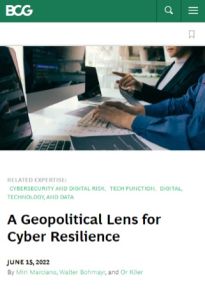Join getAbstract to access the summary!

Join getAbstract to access the summary!
Miri Marciano, Walter Bohmayr and Or Klier
A Geopolitical Lens for Cyber Resilience
Boston Consulting Group, 2022
What's inside?
Is your organization a cyber lion, or an undersized, limping cyber gazelle?
Recommendation
How do you protect a small business, a corporation, a nation? Guard secrets, stay ahead of the competition and, if you’re a nation, prepare to defend your country by land, sea and air. But what about cybersecurity? In 2016, NATO identified cybersecurity as the next theater for modern warfare, urging member countries to cooperate in fighting and recovering from cyber threats. Geopolitical cyberattacks aren’t only directed at government entities, however. Private service providers are also under attack. This report from the Boston Consulting Group outlines cybersecurity measures vital to every organization.
Summary
About the Authors
Miri Marciano, Walter Bohmayr and Or Klier are professionals with the Boston Consulting Group.


















Comment on this summary